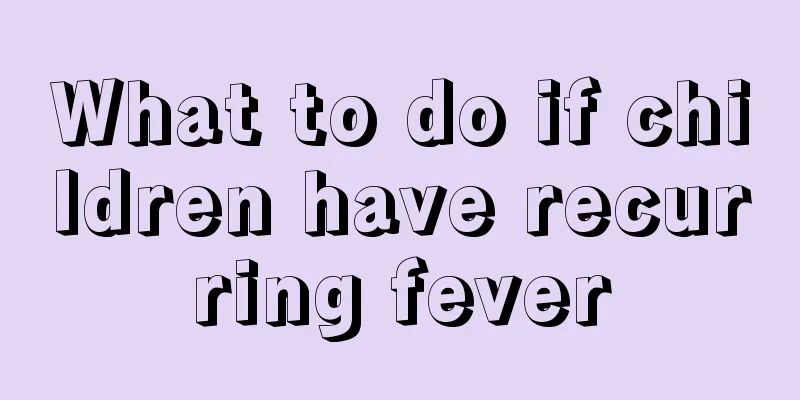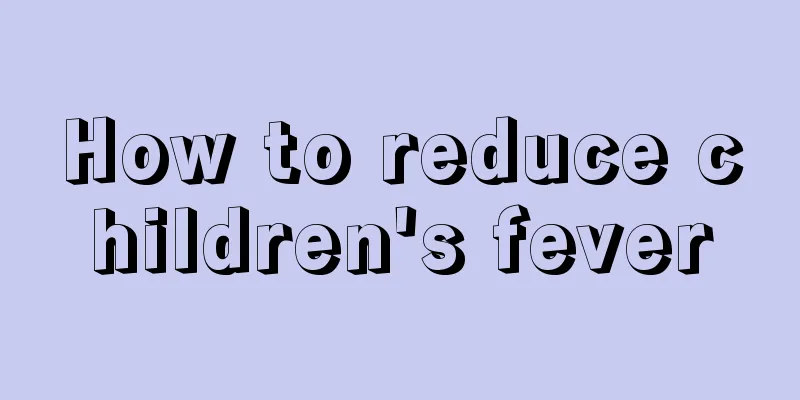What to do if children have recurring fever

|
Children's bodies are particularly fragile and their resistance is particularly poor, so many children are particularly prone to repeated fevers. Repeated fevers are particularly harmful to children, so I want to know specifically what to do if children have repeated fevers? In order for you to understand it as soon as possible and for your child to recover as soon as possible, come and see the detailed answer below. 1. What to do if your baby has repeated fever 1. Pay attention to your child’s mental state. If the child has a high fever but is in good spirits, and can still laugh and play after taking medicine to reduce the fever, and is almost the same as usual, it means that the child's condition is not serious and he or she can be rest assured to recuperate at home. If the child is listless, tired, and has a dull expression, it indicates that the child is seriously ill and should be taken to the hospital immediately. 2. Observe the child’s complexion. If the child's complexion is normal or flushed, you can rest assured to take care of him at home; if his complexion is dull, yellow, blue, or purple, and his eyes are dull, it means that the condition is serious and he should be sent to the hospital. 3. Observe whether the child has severe, projectile vomiting. If so, it indicates a brain disease, and the child should go to the hospital. 4. Check whether there is any rash on the skin. If there is, it indicates an infectious disease or drug allergy. Check whether the skin is purple or cool. If there is, it indicates circulatory failure. In both cases, you need to go to the hospital again. 5. Observe whether the child has abdominal pain and bloody stools. Abdominal pain that does not allow massage indicates acute abdomen, and bloody stools indicate dysentery, etc., and you must go to the hospital. Physical cooling methods. 2. Physical cooling methods for babies with fever 1. Ventilate more, pay attention to heat dissipation, and keep the indoor temperature between 21℃ and 23℃. 2. Let the child rest in bed and sleep more. Ensuring adequate sleep can be beneficial to the recovery of the disease. Open the blanket or take off too much clothes, wear loose clothes, and avoid wrapping yourself with a quilt. 3. Give them some fresh fruit and vegetable juice appropriately. If they accidentally overfeed, you can massage the child's abdomen to promote digestion, or eat some foods that promote digestion, such as Babyle Children's Probiotic Granules. The Bifidobacterium infantis and Lactobacillus casei in Baby Le probiotics can form a protective barrier on the surface of the intestinal mucosa to resist invasion and damage to the intestinal mucosa. They can produce acidic substances such as lactic acid and acetic acid, creating an environment that is not conducive to the growth of harmful bacteria, inhibiting the growth and reproduction of harmful bacteria, and playing a role in regulating the intestinal flora. 4. Use ice packs to apply mainly to the limbs, under the neck, and under the armpits. Avoid applying ice packs on the heart and head. This is the only way to reduce fever correctly without hurting the child. 5. For high fever, you can use alcohol to wipe the baby's joints, take a warm bath, and soak the child in warm water 4℃-6℃ lower than body temperature for 5-10 minutes. Then wipe the whole body dry with a large towel and gently massage the skin until it turns red. You can also use warm water at 32℃ ~ 34℃, which is not hot enough to wash the skin on the inside of an adult's wrist, to bathe the child, focusing on scrubbing the forehead, neck, armpits, groin and limbs. The entire bathing time is 10 to 15 minutes, until the child's temperature drops to 38℃). Generally, antipyretics should be used after the body temperature reaches 39 degrees. However, when infants and young children under 3 years old have a high fever, physical cooling methods should be used first. Generally, antipyretic injections and antipyretic drugs are not required to avoid collapse and drug toxicity reactions. What should you do if your child has recurring fever? The above content provides a detailed introduction. Therefore, as parents, you must pay attention to children who often have this situation, understand the above content, and then have your child undergo a comprehensive examination in a regular hospital. Then, through regular treatment, let the child recover as soon as possible. |
<<: Why does my baby sleep restlessly at night?
>>: Reasons why children don't eat
Recommend
Why does a three-month-old baby have tears in his eyes?
The eyes of newborns are most vulnerable to exter...
Why are there red spots on my baby’s tongue?
Geographic tongue is a very common symptom in chi...
Why is there a rash on the baby's palms?
The baby's skin is the softest and most fragi...
Is it right to check blood when the baby coughs?
Coughing is a common disease among humans. This d...
Reasons for baby's indigestion and diarrhea
We know that babies are prone to indigestion symp...
Causes of herpetic pharyngitis in children
Herpetic pharyngitis in children is a headache fo...
How to treat IGA nephropathy in children?
Some children suffer from certain kidney diseases...
What are the dangers of insufficient sleep for students?
Lack of sleep is very harmful to students. Studen...
What should I do if my child has a fever and high blood test results?
Fever is a common disease in children. If a child...
Why is my child's hair turning yellow?
Many people think that since they are Chinese, th...
What are the free pediatric vaccinations?
With the rapid development of the economy, the in...
The child has a low-grade fever of more than 37 degrees
Although a person's normal body temperature i...
What to do if your child has nystagmus
Children often have congenital nystagmus. This di...
Causes and treatments of rhinitis cough in children
We all know that many people have experienced cou...
How to treat children's hand shaking when writing
Writing is something every student has to do ever...









